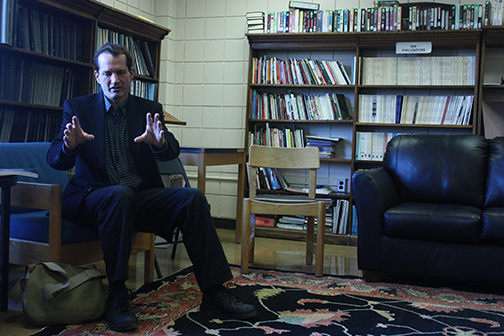
Interview with 2015 Digital Arts Writing Awards Recipient, Jon Ippolito
| May 21, 2015 | |
| Art of the Spanish Americas |
THOMA FOUNDATION: When and why did you begin writing about digital art, and why has it been important for you to contribute to scholarship in the field?
IPPOLITO: At the end of my first year in college, I flipped a coin to decide between a major in Fine Art or Astrophysics. The universe seemed to decide at that moment that I should become scientist, though it mercifully corrected its mistake three years later when I didn’t get into any graduate schools. So I became an artist—but I should have known I would be forever stuck at the intersection of art and technology. Even as an undergrad I wrote an essay for a college magazine about how computers could create non-sequential music. Seven years later I stumbled into a curatorial position at the Guggenheim after applying for what I thought was a job as a guard.
One of my first publications on art and technology was a 1996 Flash Art article entitled Where Did All the Uncertainty Go? Of the dozen artists whose work I discuss in the article, only a couple used anything resembling digital media. One based her work on GPS, another on television, a third simply painted iconography from the edges of computer screens onto the wall. The other artists made what history has come to pigeonhole as conceptual art or performance art. Nevertheless what all the works had in common was questioning the reliability of information, or what in today’s bot-accelerated media frenzy we have come to call data. I was interested in how many viewers and critics—and even some of the more naïve of the artists themselves—used information as a cloak of authenticity and relevance. (We see this today in the academic obsession with Big Data.) For me, however, the best of these works undermined information’s apparent certainty while highlighting its variability.
I believed then, and still do today, that so-called digital art has more to tell us about information than how to make pretty pixels. I’m less interested in convincing mainstream curators and collectors to buy a Camille Utterback installation or jodi.org website than to use such works as levers to pry out and examine our unconscious assumptions about technology’s seemingly inevitable effects.
THOMA FOUNDATION: Who are some of your influences (thinkers, writers, artists, educators, etc.)?
IPPOLITO: My most powerful influence has been not the writing I admire but the writing that I don’t. Comb through an art magazine, journal or book and you’re more likely to find sentences like “What’s at stake constitutes a ludic return to the chromatic semiotics of pictorial space” than “She likes to play with color.” To educate myself about art required plodding through pages and pages of such bloated abstractions. Fortunately, now that I’m a grownup, I find pretense and shallow thinking make for excellent inspiration. My best essays often start as a response to someone who pissed me off on an email list.
Along the way, I’ve also found writers who were both deep and down-to-earth, several of whom I was lucky to know first- or second-hand. I appreciate art historian Leo Steinberg, for his knack for alternating between big ideas and a close reading of the image; Mel Bochner for proving an artist could be both articulate and good; and John Cage for demonstrating that simple words could shake the foundation of a discipline. I’m also indebted to close personal colleagues like Larry Weinstein, whom I worked for at the Harvard Writing Center, for his advocacy of the concrete over the abstract; and Joline Blais, now at the University of Maine, who helped teach me what theory is and isn’t good for.
These influences predated the Internet age. Nowadays a writer doesn’t pen words by herself in a garret so much as shout them in a crowded room. Anything you write gets almost instant feedback in the form of comments and tweets from a global readership.
Of course, in the room with you are other writers also shouting for attention. Contrary to expectations, those rival voices are not just taking up your airspace; they’re also drawing more people into the room, and thus into a conversation with you and your ideas. My writing has been shaped by the contributions, criticisms and collaborations of smart people like Steve Dietz, Christiane Paul, Matthew Kirschenbaum and too many others to name.
THOMA FOUNDATION: What kinds of programs would you like to see supported in the field?
IPPOLITO: In one of my proudest achievements as a curator, I helped get performance artist Laurie Anderson a gig as NASA’s first artist-in-residence. If I had a giant claw like one of those arcade machines, I would also pluck writers out of art history departments and art magazines and scatter them across a broader landscape of cultural production. I want more artists embedded in Silicon Valley and in climate change think tanks. I want conservators in studios so they can watch a digital work be made and thereby understand how to keep it ticking in the future.
I remain unconvinced by most of the publishing software available today. Do we really think that WordPress is an adequate medium for writing in an electronic network? (Don’t get me started on Microsoft Word.) As one example, on the Yasmin email list Roger Malina recently drew a half-dozen old-timers out of the woodwork to talk about how their computer art from the 1960s might live on in the 21st century. We need a software pipeline to convey valuable historical accounts like these, from their eruption in ephemeral online forums to publication vehicles that can share them in a broader and more lasting fashion.
Our community also needs a better balance of voices. Back when net art was young many of the most prominent artists hailed from places like Slovenia and South Korea, not just the geographic capitals of culture. Joline Blais and James Leach have argued that the insights of indigenous peoples like the Wabanaki and Nekgini can be critical to a networked society. As digital art goes mainstream, we need to strive not just for gender and ethnic inclusion but also cultural diversity.
So I am looking at breathing new life into a platform I started with Craig Dietrich and John Bell called ThoughtMesh, which automatically connects writing on similar themes spread across the Web. We designed ThoughtMesh to be a platform that actively encourages artists and media historians to rub shoulders with anthropologists and poets. And I hope it will serve to connect a wider demographic of writers on these topics.
THOMA FOUNDATION: Briefly describe your current writing projects and/or those you anticipate beginning or completing in the next year?
IPPOLITO: I just finished a book written with Richard Rinehart called Re-Collection: Art, New Media, and Social Memory, which I expect will offend a lot of curators, conservators and archivists. Re-collection argues that in the past few centuries we have undervalued performative forms of memory—but we can’t keep doing that or digital culture will be lost to posterity completely.
I also just finished an as-yet unpublished essay recounting the remarkable discovery of Andy Warhol’s digital art, as well as a piece with John Bell on augmented reality as a threat to the authority of museums. As for the future, someday I hope to publish an anthology of sorts with some older essays together with new screeds about bottom-up approaches to education, preservation and the law in a single anthology.
THOMA FOUNDATION: How do you anticipate this award will impact your career and work?
IPPOLITO: Winning a Thoma Foundation fellowship is a great pretext to write my next book—but it also gives me more time for the trenches. By writing Amazon reviews of books on art and technology, I’ve tried to draw attention to networked art and ideas beyond the Media Art Ghetto (not to mention the slightly larger Art Ghetto). In article comments and email lists, I warn curators of the threat of technological obsolescence, learn how creators are using open licenses and harangue technologists to champion net neutrality.
My fellow artists, critics and curators have often bemoaned the lack of a broader appreciation for art that engages new media, one of the dominant themes of our era. I have long seen it as part of my job to rectify this by advancing greater awareness of these innovative forms of creativity, both inside and outside the art world. This extraordinary award will offer me a stage from which I can shout that message to more people, but also help me build stages like ThoughtMesh to amplify other voices as well. I hope to be helping my fellow foot soldiers nourish and preserve art of the networked age for decades to come.
THOMA FOUNDATION: What would assist you in moving your current projects and/or ideas forward?
IPPOLITO: Few ideas succeed that have a single standard-bearer. My ideas are most likely to progress into the future if they are picked up, modified and repurposed by a younger generation. We veterans benefit by cultivating a diverse group of younger practitioners. That’s one reason I’m very happy the Thoma Foundation has chosen to recognize bright young scholars like Joanne McNeil in addition to battle-scarred old-timers such as myself.
